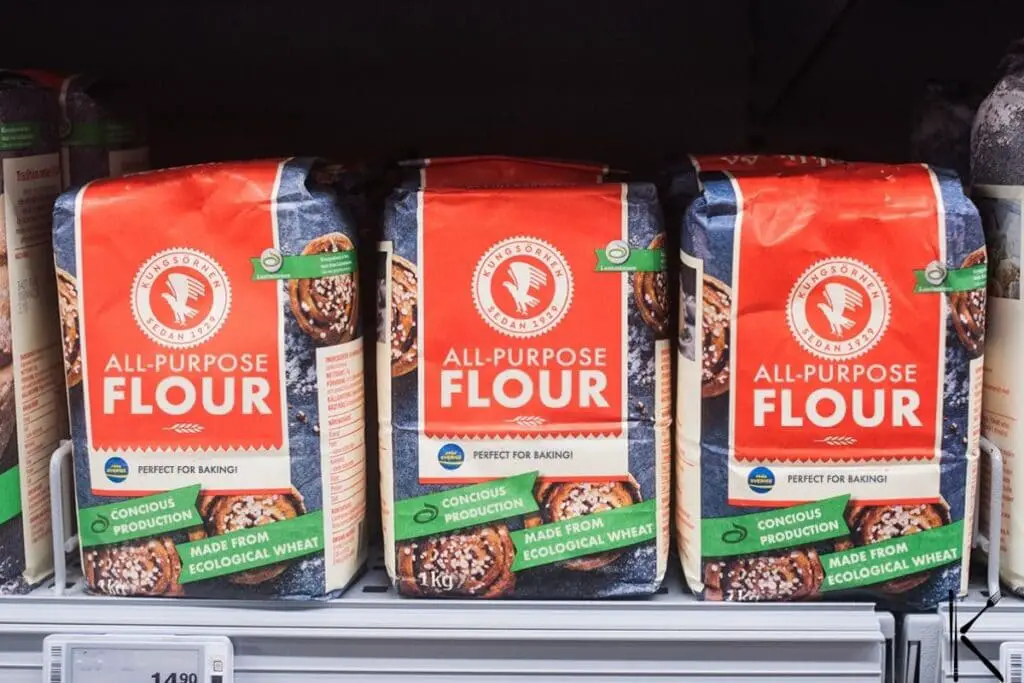In short: Yes, flour can go bad, and its shelf life varies depending on the type. Signs of spoiled flour include unpleasant odor, mold growth, rancid taste, and the presence of insects. To best store flour, use an airtight container, consider refrigeration or freezing for longer storage, and avoid damp places to prevent spoilage.
Many of us buy larger quantities of flour at once, but not sure how long it can last? We bring you all about the durability and storage of this essential ingredient.
There are few who buy only one kilogram of flour in a store. We usually buy at least a pack of six bags, sometimes a dozen. We are used to having flour at home at all times. Although we often use it, we can have a few bags left for a long time.
Now follows the question of all questions – can flour spoil? The answer is yes, and quite sooner than you probably thought. Flour is actually a highly perishable good and requires careful storage. Find out in our article everything you need to know about shelf life of flour.
How Long Does Flour Last?
Flour is a powder obtained by grinding mainly cereals. But today, we have types of flour from hundreds of different sources. The most famous and most widely used is white flour from wheat. But, in addition to the most common types of whole grains, you also have flour from coconut, almonds, hazelnuts, and many other plants. Although some common characteristics exist, the duration will depend on the type of flour.
White all-purpose refined flour
White wheat flour will last the longest due to the method of production. It has the least fat present and will therefore be somewhat more durable. It is estimated that this type remains fresh for approximately one year at room temperature.
Whole-grain flour and other
This type of flour is not as refined as is the case in regular white. Bran and germ are left here during processing, and therefore the fat content is higher. Therefore the shelf life may be somewhat shorter, so be sure to inspect the whole wheat flour well before consumption. The same goes for other types of flour. They all have a shelf life of about three months to a maximum of six months.
Can Flour Go Bad?
Although you may have been convinced that this ingredient cannot be spoiled, we assure you otherwise. Many changes to flour can occur over time, and yes, some of them will cause food poisoning. So carefully inspect the product you are using and if you notice any of the symptoms below, know that it is ready for the trash.
Sign 1: Flour smells unpleasant
The flour has almost no odor. This is especially true of processed white wheat flour. If what you have in front of you shows any unusual odor, throw it in the trash. The product may be perishable and have harmful bacteria that will not be visible to the eye, but you can smell them.
Sign 2: Mold appeared
Mold is more often possible in nut flours with more fat, almond, coconut flour, or whole wheat flour grains. Mold can be vivid by changing color or the appearance of threads that will seem like a cobweb. Be sure to throw such a product in the trash because you can get food poisoning.
Sign 3: It has rancid taste
Another good indication that the shelf life has expired is the taste. If a rancid flavor appears, it means it’s time to throw away the product.
Sign 4: Moths appeared
Yes, fresh flour is a desirable home to some insects. If you notice something squirming, it is a sure sign that some other creatures have taken over your food.
Which is the Best Way to Store Flour?
With your storage habits, you can greatly help food to prolong its shelf life. When we talk about flour, these are some of the safest storage tips. The same rules apply to all gluten free flours as well.
Tip 1: Put it in an airtight container
Air circulation will lead to the potential development of bacteria. Therefore it is best to put the product in a well-sealed container. Don’t forget to write what the expiration date is before you throw away the original packaging.
Tip 2: Put it in the fridge or freezer
It would be a good idea to leave the quantities you do not intend to use any time soon in the fridge or even the freezer. This way, the cold will slow down the development of microbes.It is especially advisable for whole grain flours.
Tip 3: Avoid damp places
Flour does not like moisture at all. In addition to spoiling its texture and probably badly affecting your culinary skills, it will further enhance spoilage. So avoid dump places at all costs and keep the product in a very dry place.
FAQs
What happens if you use expired flour?
Using expired flour might result in baked goods with a subpar texture, flavor, and rise due to the potential loss of leavening agents’ effectiveness. While it’s unlikely to be harmful, the quality of your baked goods could be compromised.
How can you tell if the flour is rancid?
You can tell if flour is rancid by smelling it—rancid flour often has a sour, musty odor. Additionally, visually inspect the flour for discoloration, clumps, or the presence of insects, as these are signs of spoilage.
How do you store flour for years?
To store flour for extended periods, keep it in an airtight container in a cool, dry place away from sunlight. Adding an oxygen absorber can further help prevent spoilage. Properly stored, flour can last for several years without a significant decline in quality.
What can I do with rancid flour?
Rancid flour is best discarded as it can negatively impact the taste and quality of your recipes. Avoid using it to ensure the best results in your baking and cooking endeavors.
Is 2 year old flour still good?
Yes, 2-year-old flour is generally still good to use, but its quality might have diminished, potentially affecting your baked goods’ outcome.
Conclusion
Grain flours are genuinely one of the essential foods we have. Although more and more recipes, especially for cakes, do not include this traditional wheat base, it is still very present in cooking. That is why we are very inclined to buy large quantities and keep them in the pantry. However, flour is prone to spoilage and cannot last for years, as many people mistakenly believe.
The best thing you can do is buy smaller quantities and renew your stock more often. Also, keep the products in a dry and cool place. Do not allow moisture to damage the packaging and spoil the contents. And further, do a light inspection before you start cooking. Your flour can also hide small insects that you will not notice in speed.
You might find these tips on yeast durability helpful and hot to tell if the rising potency is lost.
Up next: Wheat flour alternatives









